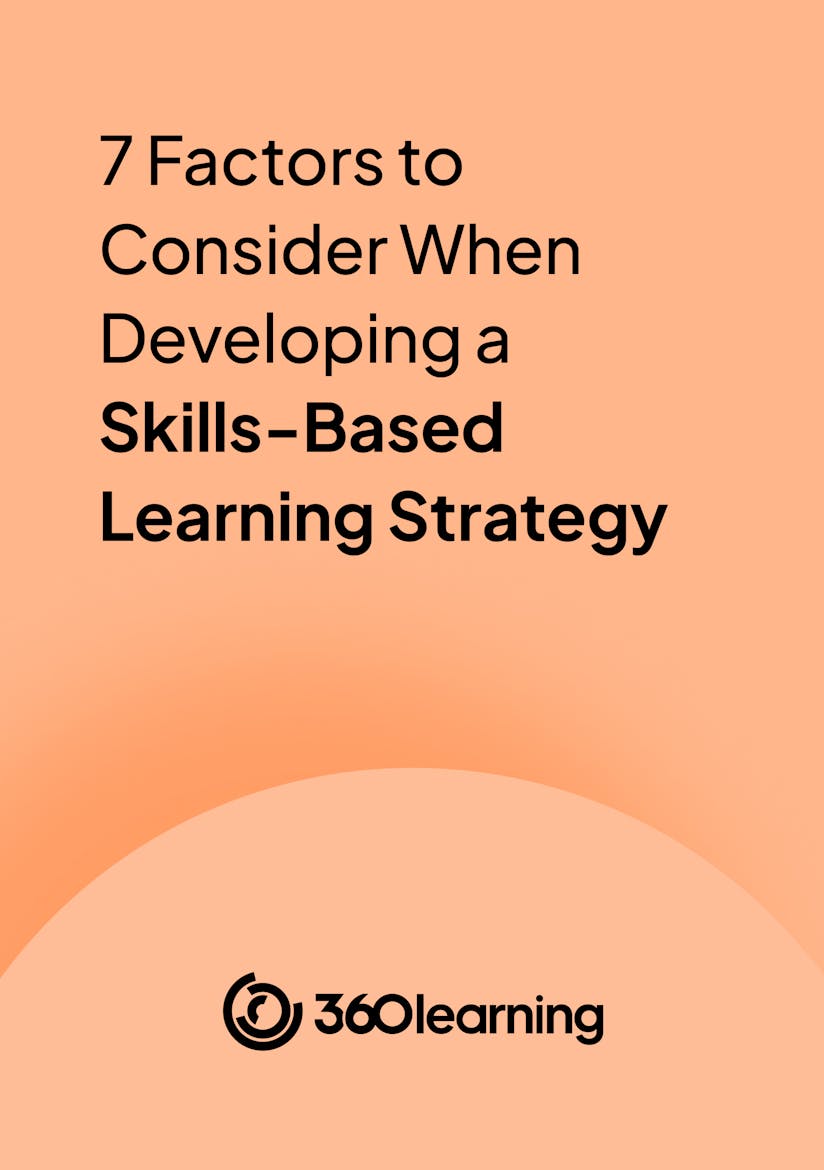
Today’s L&D teams are facing a perfect storm of challenges.
Technology is advancing faster than most training programs can keep up, making it harder to close critical skills gaps. The talent pool is shrinking, putting pressure on businesses to do more with less.
Meanwhile, the workforce itself is changing—older generations are leaving the workforce and taking their valuable experience and knowledge with them. And let’s not forget the unpredictable global landscape that adds an extra layer of complexity to the mix.
To ensure that our organizations can overcome these challenges and foster agility, agency, and equity, we need to rethink training by leveraging skills-based learning to close the skills gaps of today and tomorrow.
This article outlines why pivoting to skills-based learning is key for your business and the three skills models that will guide your skills development. We also explore the difference between transferable and proprietary skills and when each are needed, how to create a skills-based training program, and the future of skills development powered by artificial intelligence (AI).
Is skills training the best fit for your business?
A skills-based learning approach is crucial for organizations with an appetite for agility, agency, and equity.
Agility
According to the World Economic Forum, 44% of employees’ core skills will be disrupted by 2027, and technology is moving faster than traditional training programs can keep pace with.
Skills training is an agile and flexible approach that helps you and your team identify the skills necessary for your business to thrive in the market. Skills-based learning is critical to staying ahead if your organization wishes to maintain its competitive edge.
Agency
Employees are increasingly driven to take charge of their own skill development and performance within the framework you and your team establish.
LinkedIn’s 2023 Workplace Learning Report found that 94% of employees would stay at an organization longer if it invested in their learning and development. A skills-based learning approach empowers learners to take control over their learning and will drive your organization’s overall performance and productivity.
Equity
Skills-informed decision-making for hiring, pay, and promotions will help your organization reduce bias and improve fairness.
Employees who are never recognized are 27% more likely to look for another job. However, pivoting to a skills-based approach establishes a system where all major HR decisions are no longer based on job or experience but on skills. With skills training, your business will foster an environment of equity.

Guarantee a successful move to skills-based L&D
By providing your contact info, you agree to receive communications from 360Learning. You can opt-out at any time. For details, refer to our Privacy Policy.
How to develop training for skills development
When creating training programs for skills development, it is best to categorize skills based on their scope and the speed at which they evolve.
These categories are the leadership model, the job-specific performance model, and the emerging skills model. Understanding these three categories gives you and your team a clear framework for designing your skills development programs. Conversations with your stakeholders become more manageable because the framework helps you clearly define the priorities of your skills training.

Where to start your skills development project
1. The leadership model
The leadership model for skills development focuses on the common and enterprise-wide skills learners need to succeed in your organization.
You will need to identify the skill sets defining leadership excellence and your organization’s culture. These learning experiences are designed to help facilitate employees' career development, including promotions and internal mobility.
Leveraging the leadership model empowers you to identify the readiness of new managers and leaders. Once you’ve identified the skills gaps, collaborate with your top leaders, such as through a Leadership academy, to design learning experiences that equip employees with the right skills to be successful in your organization.
Examples of skills that the leadership model targets include communication, team building, problem-solving, and conflict resolution.
2. The job-specific performance model
The job-specific performance model aims to maximize business performance by focusing on the function-specific skills required to perform well in a role.
To develop skills training under this model, you and your team will need to define an ideal contributor's skills and proficiency levels. The job-specific performance model is suitable for upskilling employees to perform better or prepare them for a new role as part of their career development.
To help you get started, consider leveraging an AI-powered tool like SkillsGPT to generate the skills for an individual job in minutes. Then, with the help of your stakeholders, add your organization's nuance.
The job-specific performance model covers skills such as those required in customer service, sales, graphic design, and data analysis roles.
3. Emerging skills model
The emerging skills model helps you prioritize crucial new skills required in your industry, especially in response to technological advances or digital transformation.
When developing skills under the emerging skills framework, the goal is to focus on specific skills that, when developed, will empower your organization to respond to changes in the market at pace. These initiatives will usually be project-based and target both soft and hard skills.
You and your team may be required to collaborate quickly with internal experts to develop emerging skills training materials. A modern solution that empowers subject-matter experts to contribute easily will help you maximize upskilling experiences under this model.
Examples of skills under this model include AI literacy, cybersecurity, remote leadership, and blockchain.
Identifying skills needed for the modern workforce
When developing skills training, you will need to identify the in-demand and specific skills required to future-proof your organization.
Start with a skills audit to help you understand the skill sets you need and determine whether or not they are in place.
From here, consider the following actions to pinpoint those skills you need:
- Review industry reports and market analysis regularly to understand emerging trends and in-demand skills.
- Study competitors to see what skills they prioritize in their job postings and employee development programs.
- Attend industry-specific networking events, webinars, and conferences to gain insights into the skills that are becoming increasingly important.
- Survey employees regularly to identify skill gaps and areas where they feel additional training is needed. Alternatively, a learning solution that empowers learners to self-assess their skills and proficiency levels will speed up this process.
- Collaborate with your subject-matter experts. They will know what skills are emerging and what is needed in your organization’s context.
To help you understand the skills you should look for, let’s differentiate between the types of skills.
Hard skills and soft skills
At a base level, skills were traditionally categorized into either hard or soft skills.
Hard skills: Also called “know-how” or technical skills, these are the teachable abilities or knowledge often acquired through training programs, certifications, and on-the-job training. Examples include proficiency in Java or Python, data mining, academic writing, or carpentry.
Soft skills: Typically defined as interpersonal skills, these are the personal attributes or abilities that enhance a person’s interactions in the work environment, job performance, and personal development. Examples include written communication, adaptability, problem-solving, and emotional intelligence.
But when you rethink your training and pivot to a skills-based approach, you should consider two more specific categories that will underpin how you develop and implement your upskilling initiatives.
Transferable vs proprietary skills
When designing learning interventions to close skills gaps, you and your team need to identify whether you are targeting transferable or proprietary skills.
Transferable skills are abilities or attributes that can be applied across different jobs, industries, and roles. Because they are so wide-ranging in the work environment, transferable skills are the easiest to acquire and develop. Transferable skills include teamwork, mentoring, time management, and initiative.
In contrast, proprietary skills are more challenging to acquire and develop but are more critical to your organization’s context and staying ahead of the competition. Proprietary skills are intrinsically linked to your company’s culture, processes, and products. Because these skills are context-specific to your organization, they cannot be upskilled with off-the-shelf content.
When designing upskilling learning interventions to impact proprietary skills, a collaborative learning approach is the only way to unlock the internal knowledge within your organization. By empowering your subject-matter experts to become content champions, you and your team can develop upskilling initiatives that make an impact.
How to create a skills-based training program
If you’re interested in creating a skills-based training program, here are five steps to get you and your team started.
1. Conduct a skills gap analysis: Your skills gap analysis will identify your company's existing skills. Next, analyze industry and job market trends to pinpoint the skills your organization needs to stay competitive. The difference between the two is the skills gap that your upskilling interventions will aim to close.
2. Set clear objectives: With your skills gap highlighted, set clear and measurable objectives for the training program and align them with business goals.
For example, if you have identified an extensive proprietary skills gap between new and existing employees, the goal should be to get new hires up to speed on these skills.
3. Create your upskilling initiatives: Design your training to cover the identified skills and select the optimal learning formats that will work in the context of your organization and suit your employees' learning needs.
Returning to the above example, you could design mentoring training opportunities to pass on the proprietary skills of long-tenured staff to your new employees.
4. Leverage the right learning solution: On an enterprise scale, you will need a learning solution with comprehensive tools that will empower your teams but also your subject-matter experts to create engaging and impactful content at pace while ensuring the upskilling meets the needs of your employees.
5. Roll out and evaluate: A common theme on The L&D Podcast with David James is that when designing and implementing learning interventions, you should start small, fail fast, and iterate. Beginning with a pilot to test employee reception and the impact on business goals helps prove return on investment and identify how to scale the initiative.
Be sure to monitor the impact of your upskillinglearning experiences and continuously refine and update them so they stay effective and relevant.
The future of skills training with AI
With L&D-specific AI-powered solutions, you can work quickly to stay agile and flexible as your organization adapts to market changes.
Until now, skills mapping and creating skills ontologies have been unapproachable for many L&D teams. However, AI makes designing and implementing effective upskilling and reskilling interventions more than possible.
A solution, such as Skills by 360Learning, empowers you to map out individual skills based on role, experience, tenure, and seniority. From here, you can build courses and assessments to develop these skills, iterate and improve your learning experiences, and push the right content to the right employees.
AI-powered upskilling through collaborative learning will help you understand the skills you need. Look for tools or solutions with functionality for skills ontologies, a Skills dashboard, or even smart ontologies. All these features will help you keep a pulse on the skills inside and outside your organization.
Be sure to check out SkillsGPT, designed to generate a skills inventory for each job within your organization, build a proficiency grid for every skill, and identify the criticality level for each skill within your organization.
Frequently asked questions (FAQs)
What is the importance of skill development in the modern workforce?
How can a company identify and address skill gaps?
How can organizations effectively implement skills training programs?
What role do certifications play in skills training and professional development?




